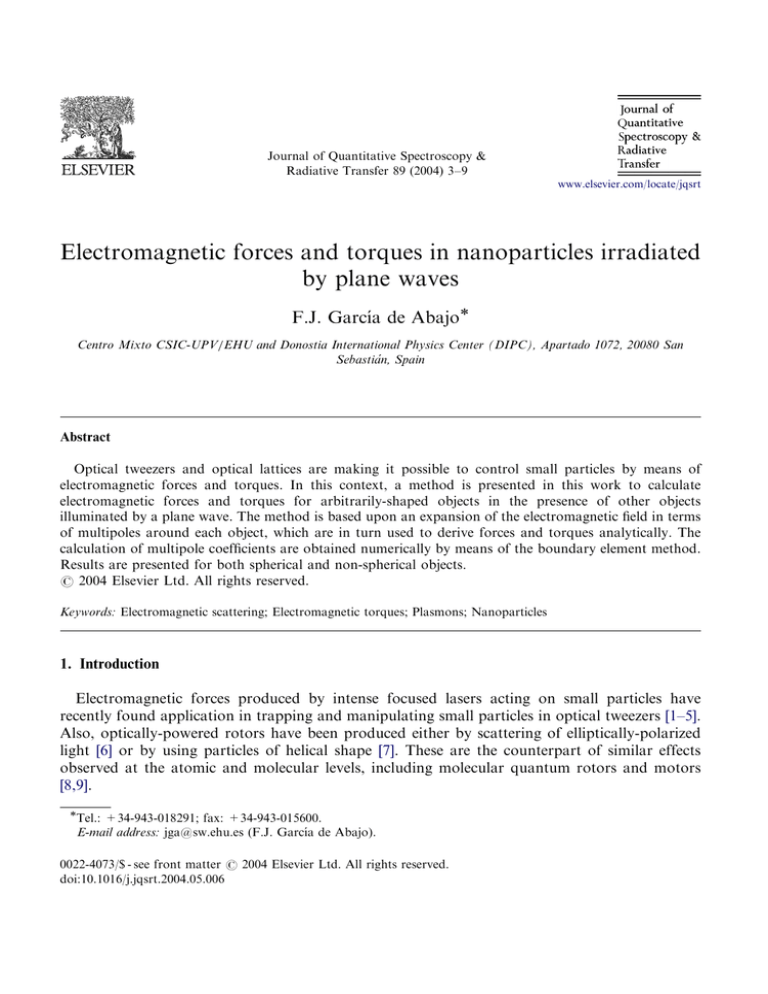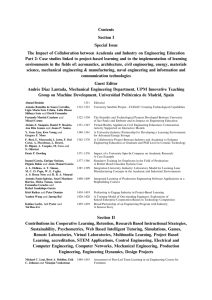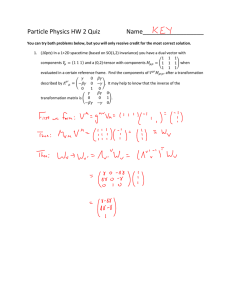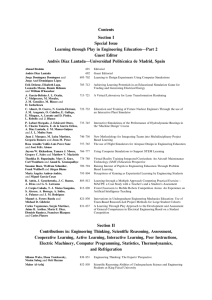
ARTICLE IN PRESS
Journal of Quantitative Spectroscopy &
Radiative Transfer 89 (2004) 3–9
www.elsevier.com/locate/jqsrt
Electromagnetic forces and torques in nanoparticles irradiated
by plane waves
F.J. Garcı́a de Abajo
Centro Mixto CSIC-UPV/EHU and Donostia International Physics Center (DIPC), Apartado 1072, 20080 San
Sebastián, Spain
Abstract
Optical tweezers and optical lattices are making it possible to control small particles by means of
electromagnetic forces and torques. In this context, a method is presented in this work to calculate
electromagnetic forces and torques for arbitrarily-shaped objects in the presence of other objects
illuminated by a plane wave. The method is based upon an expansion of the electromagnetic field in terms
of multipoles around each object, which are in turn used to derive forces and torques analytically. The
calculation of multipole coefficients are obtained numerically by means of the boundary element method.
Results are presented for both spherical and non-spherical objects.
r 2004 Elsevier Ltd. All rights reserved.
Keywords: Electromagnetic scattering; Electromagnetic torques; Plasmons; Nanoparticles
1. Introduction
Electromagnetic forces produced by intense focused lasers acting on small particles have
recently found application in trapping and manipulating small particles in optical tweezers [1–5].
Also, optically-powered rotors have been produced either by scattering of elliptically-polarized
light [6] or by using particles of helical shape [7]. These are the counterpart of similar effects
observed at the atomic and molecular levels, including molecular quantum rotors and motors
[8,9].
Tel.: +34-943-018291; fax: +34-943-015600.
E-mail address: jga@sw.ehu.es (F.J. Garcı́a de Abajo).
0022-4073/$ - see front matter r 2004 Elsevier Ltd. All rights reserved.
doi:10.1016/j.jqsrt.2004.05.006
ARTICLE IN PRESS
4
F.J. Garcı´a de Abajo / Journal of Quantitative Spectroscopy & Radiative Transfer 89 (2004) 3–9
In this work, we calculate electromagnetic torques acting on elongated particles illuminated by
a plane wave. We show that the magnitude of these quantities, as well as the sign of the torque,
can be controlled by using the right polarization and wavelength for the external light. We use a
multipole formalism to calculate both torques and forces, which can be applied to complex
geometries involving more than one particle, as illustrated below for forces acting on metallic
spheres in the presence of neighboring particles of different shapes.
For practical applications in the context of optical tweezers [3] and optical stretchers [10], an
extension of the present study to include focused beams will be necessary, similar to the one
carried out in Ref. [5], where gradient forces are essential to achieve trapping. Even in this case,
one would expect that control over the orientation of small particles is attained by choosing the
right combination of polarization and wavelength. However, the present work can find some
relevance in different situations: (1) to control the orientation of particles in free space by
irradiating them with successive plane-wave pulses of appropriate strength, duration, wavelength,
orientation, and polarization, specially if the absolute spatial position is not so relevant; (2) to
explore the dynamics (both translational and rotational) of complex particles in inter-stellar
environments; or (3) to control the orientation and position of particles trapped against a
solid–fluid interface (the analysis becomes straightforward if the dielectric constant is
approximately the same on either side of the interface), although friction and other interfacial
forces can play a substantial role in this case.
The electromagnetic response of each of the particles considered in this work has been
expressed in terms of their corresponding multipole t-matrix, which relates the coefficients of the
multipole expansion of the induced electromagnetic field to those of the external field [11,12].
These t-matrices are in turn obtained by solving Maxwell’s equations using the boundary element
method [13,14].
2. Torques on non-spherical particles
We begin by expressing the electromagnetic field acting on a given particle in terms of magnetic
and electric multipoles in frequency space o as [15,11,12]
X M;inc
E;inc i
clm L clm
r L il j l ðkrÞ
Eðr; oÞ ¼
k
lm
M;sc
E;sc i
l ðþÞ
þ clm L clm r L i hl ðkrÞ Y lm ð^rÞ;
(1)
k
where L ¼ ir r is the orbital angular-momentum operator, k ¼ o=c is the momentum of the
light, and the field has been separated in incident (inc) and scattered (sc) components. Assuming
linear response, the coefficients of proportionality between them are given by the scattering matrix
t according to
X 0
n0 ;inc
¼
tnn
(2)
cn;sc
lm;l 0 m0 cl 0 m0 ;
lm
l 0 m0
ARTICLE IN PRESS
F.J. Garcı´a de Abajo / Journal of Quantitative Spectroscopy & Radiative Transfer 89 (2004) 3–9
5
where n runs over M and E components. The t matrix is analytical for spherical particles [11,12]
(Mie coefficients) and we have calculated it numerically using the boundary element method
[13,14] for arbitrarily-shaped objects (whiskers and torii in the examples offered below).
The torque acting on the particle in the presence of this field is a quadratic, analytic function of
these coefficients that can be obtained from the integral of the Maxwell stress tensor over a
spherical surface S of radius R surrounding the object. The time-averaged torque reads [16]
Z
R3
^ R
^ EÞðE RÞ
^ þ ðR
^ HÞðH RÞ:
^
dR½ð
(3)
G¼
4p S
Then, calculating the magnetic field H using Faraday’s law and inserting the resulting expression
together with Eq. (1) into Eq. (3), one finds
1 X
1 pffiffiffiffiffiffiffiffiffiffiffiffiffiffiffiffiffiffiffiffiffiffiffiffiffiffiffiffiffiffiffiffiffiffiffiffiffi
ðl þ m þ 1Þðl mÞdmþ1;m0 ðx^ i^yÞ
lðl
þ
1Þ
Re
G¼
2
4pk3 lml 0 m0
1 pffiffiffiffiffiffiffiffiffiffiffiffiffiffiffiffiffiffiffiffiffiffiffiffiffiffiffiffiffiffiffiffiffiffiffiffiffi
ðl m þ 1Þðl þ mÞdm1;m0 ðx^ þ i^yÞ þ mdmm0 z^
þ
2
h
i
E;sc E;sc M;sc M;sc E;sc E;inc M;sc M;inc :
(4)
clm ðcl 0 m0 Þ þ clm ðcl 0 m0 Þ þ iclm ðcl 0 m0 Þ þ iclm ðcl 0 m0 Þ
Eq. (4) has been used here to obtain the torque acting on metallic and dielectric whiskers
illuminated by a light plane wave, as shown in Fig. 1.
In the case of silver particles, the scattering cross section, which is directly obtained from the
scattering amplitude, shows a pronounced resonance when the polarization of the external light is
directed along the whisker (Fig. 1(a)). The dielectric function of silver has been taken from optical
data [17]. Part of the scattered light is absorbed by the metal (silver in this case), so that the total
cross section (solid curve, obtained by using the optical theorem [15]) is actually larger than the
elastic cross section (broken curve). The cross section for polarization perpendicular to the
particle is negligible (by a factor of 40000 at the resonance) as compared with the case considered
in Fig. 1(a).
The torque acting on this particle when it is illuminated by circularly-polarized light follows the
same profile as the scattering cross section (Fig. 1(b)). This torque is induced by the angular
momentum carried by the external light, part of which is transferred to the particle [6].
A more interesting situation is presented when linearly-polarized light is used (Fig. 1(c)), in
which case the particle tends to align itself parallel (perpendicular) to the polarization vector when
light of wavelength below (above) the resonance is employed. Here, the torque scales with the sine
of the angle between the polarization vector and the particle axis of symmetry. It should be noted
that the torque takes non-negligible values well outside the absorption resonance, so that a sizable
orientational effect can still be obtained while minimizing heat transfer to the particle (this arises
from absorption of external light). Moreover, control over the particle orientation is possible by
using the right combination of polarization and wavelength of the external light.
It is interesting to point out that the wavelength of the resonance depends on the length of the
whisker, and this offers the possibility of manipulating separately whiskers of different lengths by
tuning their respective resonances.
ARTICLE IN PRESS
6
F.J. Garcı´a de Abajo / Journal of Quantitative Spectroscopy & Radiative Transfer 89 (2004) 3–9
Fig. 1. (a) Scattering cross section for a silver whisker as a function of wavelength. The shape and dimensions of the axially-symmetric
sample are shown in the inset. Both elastic (dashed curve) and total (solid curve) cross sections are shown. The light is linearly polarized
along the axis of the whisker. (b) Electromagnetic torque for the same whisker as in (a) when it is illuminated by a circularly-polarized
light plane wave of intensity equal to 1 W/mm2 . (c) Electromagnetic torque under linearly-polarized illumination with the polarization
vector forming an angle of 451with the whisker axis (the light is coming along a direction perpendicular to the axis of the whisker).
(d)–(f) Same as (a)–(c) for a dielectric whisker of dielectric function ¼ 12.
For dielectric particles of with same shape (Fig. 1(d)–(f)), the value of the torque is one order of
magnitude smaller and qualitatively very different as compared to the metallic particles discussed
above. For instance, dielectric particles do not exhibit plasmon resonances, unlike metallic ones.
Moreover, their total and elastic cross sections are identical, since a dielectric particle (real
dielectric function) cannot dissipate energy, so that heating of the particle is avoided.
3. The effect of environment on electromagnetic forces
For aggregates formed by several scattering objects, one can still use the multipole expansion of
Eq. (1) around each of the objects. The scattered part of the self-consistent field around a given
object labeled a is the sum of contributions coming from the other objects (baa) plus the
scattering of the incident field. Both scattering at each object and propagation of the field between
objects are linear operations (this would be different in non-linear materials), so that the selfconsistent multipole coefficients satisfy the equation
!
X
inc
(5)
H ab csc
csc
a ¼ ta ca þ
b ;
baa
ARTICLE IN PRESS
F.J. Garcı´a de Abajo / Journal of Quantitative Spectroscopy & Radiative Transfer 89 (2004) 3–9
7
Fig. 2. Electromagnetic force acting on an aluminum sphere when it is illuminated in the presence of a nearby object. The light is
linearly polarized, with the polarization vector contained in the plane of the insets.
where matrix notation has been used, that is, c is actually a vector that contains all M, E, and
0
, as defined in Eq. (2) . Here, the matrix
ðl; mÞ components, and t is the matrix of coefficients tnn
lm;l 0 m0
H ab describes the propagation of the field from object b to object a, and it can be derived
analytically in terms of the coordinates of the multipole origins for the different objects [11,12].
Eq. (5) separates the geometrical configuration of the cluster, fully contained in H ab , from the
actual shape and composition of the objects, which is entirely buried into ta . A similar approach
can be also followed to treat two-dimensional geometries as well as photonic crystals consisting of
periodic configurations of the objects [18,19].
This multiple scattering formalism has been used to obtain Fig. 2, which shows the force acting
on aluminum spheres of 55 nm in diameter when a nearby particle contributes as well to the
scattering of the external field. The electromagnetic force has been calculated from the integral of
Maxwell’s stress tensor [16], which results in an analytical but complicated expression in terms of
the multipole coefficients. A Drude dielectric function has been used for aluminum, with a plasma
energy of 15 eV and a damping of 1.06 eV. The self-consistent field has been obtained by using a
method based upon multiple scattering of multipoles [11,12]. A marked influence of the
neighboring particle is observed on the force acting on the aluminum sphere, and the magnitude
and even the sign of this force changes dramatically over the photon energies under consideration
when choosing different particle shapes. This suggests the possibility of using neighboring effects
to control the relative position of particles under the influence of external light. The polarization
of the latter has been chosen to maximize these effects: a strong dipole–dipole interaction is
triggered by the component of the electric field directed along the line that separates the centers of
the objects, whereas the complementary polarization results in minor neighboring effects that
originate in higher multiple contributions.
4. Conclusions
Torques and forces acting on small particles under external illumination have been calculated in
this work under illumination by a single plane wave. Electromagnetic torques acting on whiskers,
ARTICLE IN PRESS
8
F.J. Garcı´a de Abajo / Journal of Quantitative Spectroscopy & Radiative Transfer 89 (2004) 3–9
both metallic and dielectric, have been shown to provide a possible tool for nanoparticle
alignment. The magnitude of the torque for attainable light beam intensities is sufficiently large as
to overcome other forces such as gravity and Brownian motion. Finally, the effect of neighboring
particles on the electromagnetic force acting on small aluminum spheres has proven to be very
large, suggesting a possible way to manipulate the relative orientation of neighboring objects
under external illumination. The present study can be easily generalized to account for
illumination under focused beams, which will be needed to discuss situations of practical interest
in optical tweezers.
Acknowledgements
The author acknowledges help and support from the Basque Departamento de Educación,
Universidades e Investigación, the University of the Basque Country UPV/EHU (contract No.
00206.215-13639/2001), and the Spanish Ministerio de Ciencia y Tecnologı́a (contract No.
MAT2001-0946).
References
[1] Ashkin A, Dziedzic JM. Optical trapping and manipulation of viruses and bacteria. Science 1987;235:
1517–20.
[2] Chu S. Laser manipulation of atoms and particles. Science 1991;253:861–6.
[3] Grier DG. A revolution in optical manipulation. Nature 2003;424:810–6.
[4] Novotny L, Bian RX, Xie XS. Theory of nanometric optical tweezers. Phys Rev Lett 1997;79:645–8.
[5] Nieminen TA, Rubinsztein-Dunlop H, Heckenberg NR, Bishop AI. Numerical modelling of optical trapping.
Comput Phys Commun 2001;142:468–71.
[6] Friese MEJ, Nieminen TA, Heckenberg NR, Rubinsztein-Dunlop H. Optical alignment and spinning of lasertrapped microscopic particles. Nature 1998;394:348–50.
[7] Galajda P, Ormos P. Complex micromachines produced and driven by light. Appl Phys Lett 2001;78:
249–51.
[8] Hugel T, Holland NB, Cattani A, Moroder L, Seitz M, Gaub HE. Single-molecule optomechanical cycle. Science
2002;296:1103–6.
[9] Averbukh IS, Arvieu R. Angular focusing, squeezing, and rainbow formation in a strongly driven quantum rotor.
Phys Rev Lett 2001;87:163601.
[10] Guck J, Ananthakrishnan R, Moon TJ, Cunningham CC, Käs J. Optical deformability of soft biological
dielectrics. Phys Rev Lett 2000;84:5451–4.
[11] Garcı́a de Abajo FJ. Interaction of radiation and fast electrons with clusters of dielectrics: a multiple scattering
approach. Phys Rev Lett 1999;82:2776–9.
[12] Garcı́a de Abajo FJ. Multiple scattering of radiation in clusters of dielectrics. Phys Rev B 1999;60:6086–102.
[13] Garcı́a de Abajo FJ, Howie A. Relativistic electron energy loss and electron-induced photon emission in
inhomogeneous dielectrics. Phys Rev Lett 1998;80:5180–3.
[14] Garcı́a de Abajo FJ, Howie A. Retarded field calculation of electron energy loss in inhomogeneous dielectrics.
Phys Rev B 2002;65:115418.
[15] Low FE, Classical field theory: electromagnetism and gravitation. New York: Wiley; 1997. p. 217–240.
[16] Jackson JD. Classical electrodynamics. New York: Wiley; 1975.
[17] Palik ED. Handbook of optical constants of solids. New York: Academic Press; 1985.
ARTICLE IN PRESS
F.J. Garcı´a de Abajo / Journal of Quantitative Spectroscopy & Radiative Transfer 89 (2004) 3–9
9
[18] Garcı́a de Abajo FJ, Pattantyus-Abraham AG, Zabala N, Rivacoba A, Wolf MO, Echenique PM. Cherenkov
effect as a probe of photonic nanostructures. Phys Rev Lett 2003;91:143902.
[19] Garcı́a de Abajo FJ, Rivacoba A, Zabala N, Echenique PM. Electron energy loss spectroscopy as a probe of twodimensional photonic crystals. Phys Rev B 2003;68:205105.





